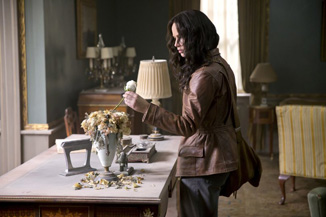Book vs. Movie - The Hunger Games: Mockingjay Part 1
By Ben Gruchow
July 2, 2015
Mockingjay, Part 1 establishes the concept of control and motivation cinematically, right from the start; the opening provides a moment that’s as dark as anything else in a fairly dark film. It’s a single line of dialogue, said right before the opening title, written for the film. It helps to reinforce a theme not emphasized in the book: that these are teenagers and young adults. The scene manages an impressive trick of allowing these young adults to be young, and to emote openly, not possessing much in the way of control (having not had the opportunity to develop it) while also contextualizing the events of the first two films in a solidly traumatic light: no heroes here, only permanently battle-scarred individuals with no optimism left.
That’s a bleak place to start your popcorn tentpole movie from, and it’s to the credit of Part 1’s consistency of tone that it doesn’t shy away from implication as it goes on. Indeed, the movie’s increased attention given to the mechanics of the Mockingjay campaign (headed up by Coin and Philip Seymour Hoffman’s Plutarch Heavensbee) continues to front the reality of: these are manipulated young adults with permanent psychological damage. The book opens with Katniss surveying the rubble of District 12; her narration tells us that she is here at her own insistence, and Coin & co. eventually caved. It’s a spare, haunting set piece, and we are clued into the fragility of Katniss’ mind, but she is there and proceeding under her own control. In the film, Plutarch pushes to have her sent to District 12 as a way of persuading her to join the campaign effort; consequently, Katniss’ reaction to District 12 in the film is considerably more raw and unsettled. The rest of Part 1 is peppered with little notes like this, and other variations on the novel’s form.
The strongest moments in Part 1 generally involve material not in the book. In one, the nation’s growing allegiance to the Mockingjay is accompanied by a folk song (the song is in the book, but not the chain of events depicted here). Another involves an attempt by Katniss to distract Snow during a stealth rescue mission, by communicating with him visually from the District 13 control room. The actual rescue sequence (also not in the book) has some striking images, but it’s narratively unnecessary; the confrontation between Katniss and Snow functions as a much more appropriate expression of Part 1’s themes. It’s a perfect counterpart to the movie’s opening. The sequence of events with Peeta’s return, and Part 1’s conclusion, follow this.
The Verdict
Mockingjay’s depiction of its protagonist and her headspace in the first half is realistic within the story’s universe, and I’d argue that it’s necessary in order to give the story’s events the proper weight, but it makes for a flatter, duller tone that’s significantly off from the narrative tightness and velocity of the first two books in the series. I limit this assessment to the first half of the book, given our circumstances right now, but this is enough to make the final book in the Hunger Games series the weakest, even if “weakest” in this case is aggressively dependent on context.
Continued:
1
2
3
4
|
|
|
|




